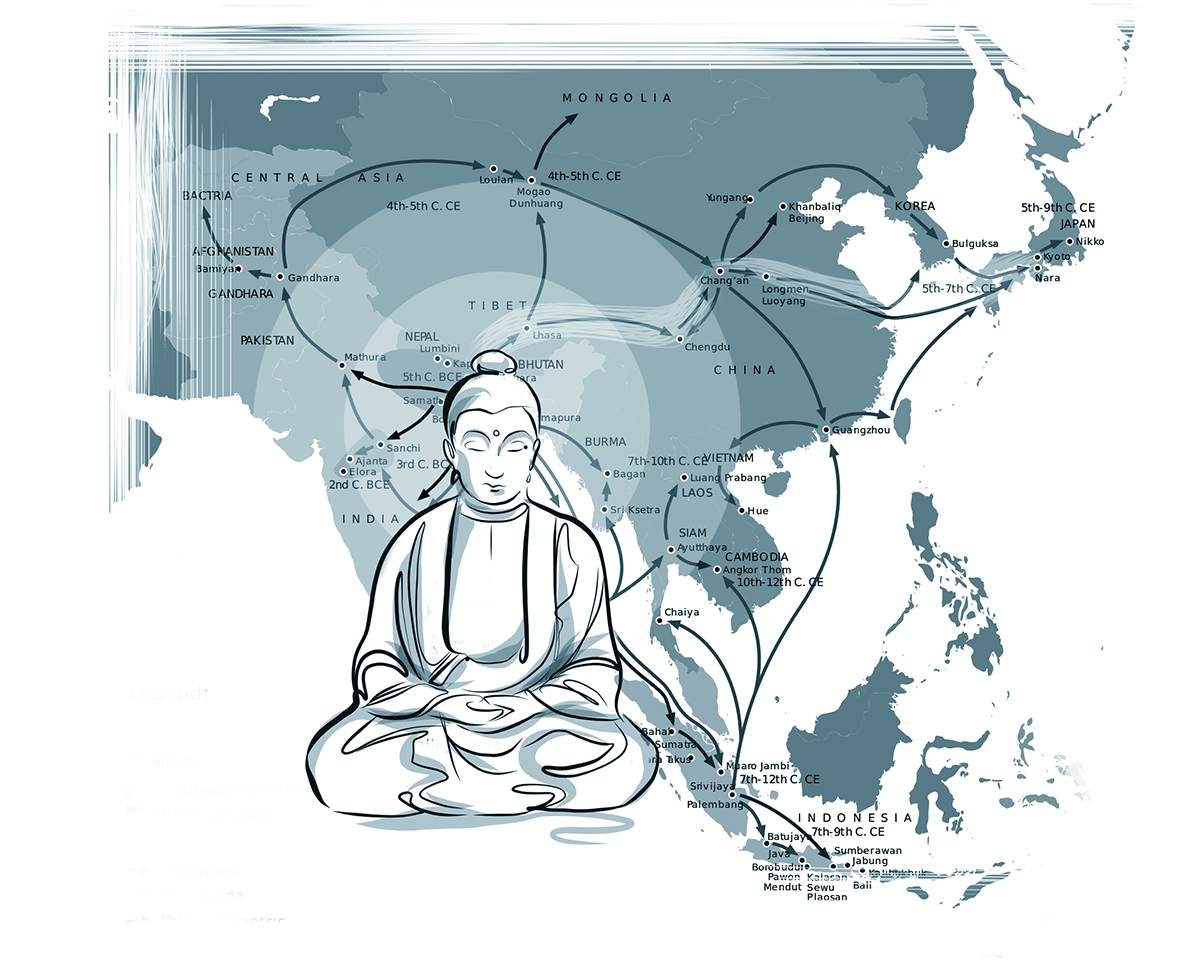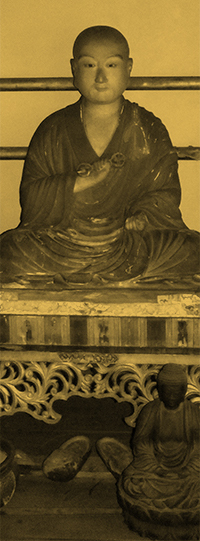Religion & Philosphy
Introduction
In today´s demographic statistics Japan´s religious background is described as mainly Shintoistic,
followd by Buddhist and Christian. That also reflects the order of cultural influences,
beginning with Shintoism long before written historical records, followed by Buddhism that was introduced
through crownprince Taishi Shotoku in the 6th century, again followed by the introduction of Christianity
through Jesuit missions in 1549.
Yet despite its high percentage in the japanese population,
Shintoism is only rarely expressed as a distinct cultural identity.
It is on the one hand part of hidden feelings towards nature or the ancestors,
on the other hand a self-evident ceremonial routine, that is repeated throughout everyday life
or on important occasions like wedding or funeral.
The word "Shinto" is translated as "The Way" and was adopted from the Chinese term "Dao".
The range of connotations is vast and "Dao" is sometimes translated as the "The Way of Nature"
or even as "God". "Dao" is linked to the partly philosophical, partly religious movement of "Daoism",
attributed to the legendary founder Lao Tzu, who wrote about the relations between natural phenomena,
personal experience and perspectives of global development. Daoism has both influences on Shintoism
as well as Buddhism and dates back to the period called "axial age" ranging from roughly the 8th
to the 4th century BC. It was a period where in many regions of the world religions and
philosophical movements took shape: in Greece Socrates and Plato started their inquiry into rational thinking,
in China Confucius and Lao Tzu founded the basic philophies of Chinese civilization and in India Prince Gautama
started a movement later called "Buddhism".
Japan is in a way connected to the all these cultural traditions,
with European philosophy being introduced in the 19th century.
 illustration of the author, based on https://en.wikipedia.org/wiki/History_of_Buddhism#mediaviewer/File:Buddhist_Expansion.svg
illustration of the author, based on https://en.wikipedia.org/wiki/History_of_Buddhism#mediaviewer/File:Buddhist_Expansion.svg
Buddhism in Japan
Buddhism originated as a protest against the Brahmanic tradition of India, lead by prince Gautama (563-483 BC)
who searched for a non-traditional approach to finding enlightment. In the next centuries "Buddhism"
was formed as a loosely connected religious and philosophical movement, based on oral tradition,
newly recorded scriptures and transmitted monastic community rules. It divided into the more monastic traditions
of South East Asia (Theravada), the broader social movement of Mahayana-Buddhism and the esoteric traditions
of the Vajrayana line.
Except of the first line of transmission, all the branches of Buddhism reached
the Japanese archipelago. Buddhism was introduced as a state religion by crownprince Taishi Shotoku
in the 6th century AD, imported from China and Korea. Three of the most important buddhist sects were then later
founded by renewed cultural exchanges with China: Zen, Tendai and Shingon.
All these sects are part of the broader Mahayana movement, that evolved around the concept of a "Bodhissattva",
an enlightened person who continues to transmit his wisdom even after entering the state of nirvana.
In the same time the concept of a "Buddha" (an enlightened one) was broadened in order to transcend historical
and cultural boundaries, thus connotating a rather psychological state with timeless attributes of bliss and
clarity. "Zen" for example is a word derived from the Chinese term "Chan" that goes back to the
Sanskrit term "dhyana", describing the state of meditation of the Buddha. So a whole tradition
was formed around the concept of enlightment, dealing with philosophical issues and more practical questions
about how to actually train yourself. In case of Shingon buddhism many ceremonial elements of other traditions
were incorporated into the Buddhist training process. These were based on Indian and Chinese esoteric traditions,
using mudras (hand signs), mandalas (visual representations) and sutras (chantings)
to find an even more experiantial approach to enlightment.
Shingon-Buddhism

Important Sites
- Shikoku islands
- Koya-San
- Daigoji-temple in Kyoto
Basic information
Shingon Buddhism (真言宗 Shingon-shū) is one of principal schools of buddhism in Japan, dating back to the 8th century. "Shingon" means, directly translated, "true word" and refers to the power of sutras (chanting). As a part of the esoteric Vajrayana traditions originating in India, it incorporates a range of ceremonial gestures and visual representations into its religious practices. Although it has grown to a widely spread monastery tradition and was even promoted to the level of state religion during certain periods of japanese history, it is nontheless closely linked to the mostly hidden traditions of asceticism and esoteric rituals, for example the tradition of "shugendo" (mountain asceticism).
Kukai
Kūkai (空海), also known posthumously as Kōbō-Daishi (弘法大師 The Grand Master Who Propagated the Buddhist Teaching?), 774–835, is the founder of Shingon Buddhism in Japan. After discontentment with traditional scholarship and restless years of harsh asceticism, he embarked on a dangerous journey to China, where he was introduced to the esoteric lineage of Buddhism by Master Hui Kuo. He returned to Japan with a bunch of scriptures, ceremonial material and mandalas and established in the following years several temples dedicated to this new interpretation of Buddhahood. Because of his extraordinary activity as a religious leader, a scholar and a statesmen, he gained a legendary status among the Japanese.

The meaning of pilgrimage
Kukai was born in Shikoku and as a religious leader established the tradition of pilgrimage on this islands.
This tradition grew over the centuries to a well-defined pilgrimage route, encompassing 88 temples,
called "reiji". These include the birthplace of Kukai, his documented travel sites,
as well as sites where he is reputed to have undergone austerities.
The meaning of pilgrimage usually lies in a mixture of sincere buddhist practice and folk beliefs.
As with other religious traditions a typical motive is the wish for self-improvement;
in other cases it might be carried out as an act of repentance.
Nonetheless it also has a deeply rooted spiritual meaning, dating back to the even pre-buddhist
Indian tradition of "pabbajana" - "leaving the house". A spiritual quest in this sense is understood
as a alternative to the more worldly concern about establishing a family or a house.